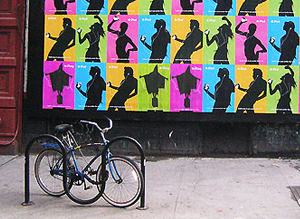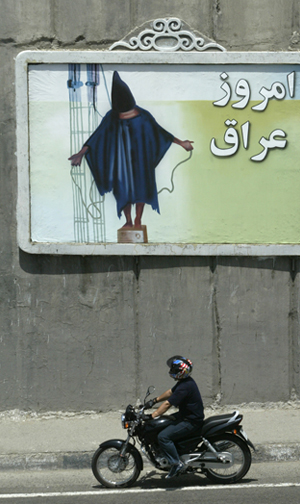Repetitive stress
Iconologist W. J. T. Mitchell argues that indelible verbal and visual images clone terror.
By Brooke E. O’Neill, AM’04

A 2004 protest poster, pasted up around real iPod ads in New York, reads: “10,000 Iraqis killed. 770 US soldiers dead.”
W. J. T. Mitchell still remembers the first image that enchanted him. He was five years old, lying in bed reading comic books, when he picked up a Catholic prayer book his mother had given him. Nested inside its front cover he discovered a tiny figurine of the Madonna. “I knew it was supposed to be holy and sacred, and yet I could see it was so tacky and plastic,” recalls Mitchell, the Gaylord Donnelley distinguished service professor in English language and literature, art history, and the College. He ran his fingers across the sculpture, “as if rubbing Aladdin’s lamp to let out the magical genie trapped in this kitschy object.”
As he grew older, the church’s visual contradictions continued to fascinate him. “Every Catholic is trained in both the magic of images and the disenchantment of images,” says Mitchell, an expert on visual culture. Consider the image of Christ on the cross. Weak and bloodied, Jesus is also perceived as powerful, man’s savior. “God,” Mitchell says, “is manifested visually as a torture victim.”
That tableau came back to haunt Mitchell in April 2004, when he saw the snapshots leaked from Iraq’s Abu Ghraib prison. Scenes of naked men, physically abused and tortured, shocked the world. Among the images was a hooded prisoner standing on a box, arms outstretched, electrical wires dangling from his fingertips. The man had been told that if he stepped down, he’d be electrocuted.
“My first thought when I saw the Abu Ghraib photograph was, ‘This is a resurrection of a Christian icon,’” says Mitchell, whose book Cloning Terror: The War of Images, 9/11 to the Present(University of Chicago Press, 2011) examines the verbal and visual world of America’s war on terror. The photograph, he says, bears an uncanny resemblance to artistic portrayals of the Passion of Christ. Elevated before his torturers, eyes obscured, and arms extended, the Hooded Man, as Mitchell calls him, recalls paintings, such as those by Renaissance painter Fra Angelico, that depict Jesus blindfolded and seated on a pedestal before a jeering crowd.
The Abu Ghraib photo became an instant symbol of the war on terror. It’s one of many pictures, videos, and pieces of text Mitchell analyzed to understand how images and words influenced public perception of the conflict. He also studied clips from the 9/11 attacks, political cartoons, and anti-American murals.
A self-described “image scientist,” Mitchell calls Cloning Terror a “literary and aesthetic reading of history.” Drawing multiple links between the war and scientific cloning, his study crosses traditional boundaries between art history, literary criticism, media studies, political science, and biology.
A multidisciplinary approach has long been a trademark of Mitchell’s work. He is a leader in a methodology known as iconology—the study of images across media—and he’s written and edited more than a dozen books on illuminated manuscripts, Dolly the cloned sheep, and Americans’ cultural obsession with dinosaurs. Editor of the literary-arts journal Critical Inquiry since 1978, he has been short-listed for the Pulitzer and the National Book Award. His next project will tackle theories of race, the media, and visual culture.

A 2004 mural of the Hooded Man along a Tehran street. The Farsi reads: “Iraq today.” Photography by Behrouz Mehri/AFP/Getty Images/Newscom.
Whatever his subject matter, Mitchell sees images as living entities; they arouse emotions and drive events. But iconology isn’t just about the visual; the study also looks at verbal metaphors. Take the phrase war on terror. For Mitchell, it’s a figure of speech that became reality. Unlike traditional military operations, fighting terror was not a battle between sovereign states but one fought against a vague antagonist. “Taken literally, it is something like a war on anxiety,” he writes. “How could it ever end? How could it be won?”
Yet the Bush Administration rallied public opinion with those words, says Mitchell, transforming a metaphor into an actual military conflict that bred more terror. As terrorists without uniforms blended with civilians, America’s traditional warfare methods—invasion, conquest, occupation—caused considerable collateral damage. These civilian casualties inspired more insurgents, who conducted more terrorist activity. The Abu Ghraib scandal fueled the fire as the Hooded Man photograph became a “recruiting poster” for jihadists.
By July 2007 the US National Intelligence Estimate reported a growing number of “radical” terrorist cells in Western countries. “Like George Lucas’s Clone Wars,” Mitchell writes, “the War on Terror seemed to promise an endless supply of faceless warriors, massed for interminable combat.” The military operation was, in effect, cloning terror.
Mitchell also makes other connections between the war and cloning. Immediately before the 9/11 attacks, he notes, scientific cloning was the main political debate. In August 2001 the Bush Administration had restricted federal funding for stem-cell development from human embryos. The front page of the September 11 New York Times featured an upcoming report from the National Academy of Sciences that argued for renewed public funding to support human stem-cell initiatives.
After the World Trade Center fell, the so-called clone wars took a backseat, Mitchell argues, but the anxieties surrounding them—nightmare scenarios of biology and technology gone wrong—fed American thoughts about terrorism. As a method of warfare, says Mitchell, terrorism is hardly novel, but it now had a new metaphor: infectious disease. Terrorism was described as a virus: military intelligence spoke of new, independent terrorist groups as “self-generating cells.” Terror was cloning itself.
The clone concept even extends to the image making that exposed Abu Ghraib. Captured on digital cameras and transmitted around the world via the Internet, the images spread quickly, duplicating themselves.
Digital photography not only enabled infinite, exact replication of the photos; it also captured the “DNA of the image,” shedding more light on the abuse. Unlike traditional photographs, digital image files carry “metadata,” such as the date and time of each photo, and the camera that took it. Using this code, Army investigator Brent Pack produced a timeline of events that ultimately led to several convictions in the prison scandal.
Meanwhile, writes Mitchell, the Hooded Man—“accused terrorist, torture victim, anonymous clone”—persists as a powerful icon. Although the phrase war on terror has fallen into disuse with the Obama Administration, such images are a reminder to Americans of “the things that have been done in their name.” Weaving together visuals and text, analogy and analysis, Mitchell has one goal with Cloning Terror. “This book,” he writes, “is at bottom a fairly simple exercise in memory and the prevention of historical amnesia.” Indeed, just like the figurine from his childhood, the imagery of the war has exacted a powerful hold on the imagination, shaping not only the past but also the future.
Return to top
